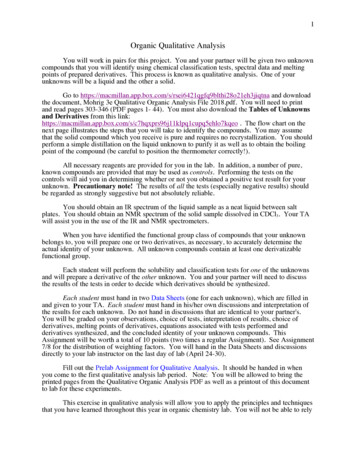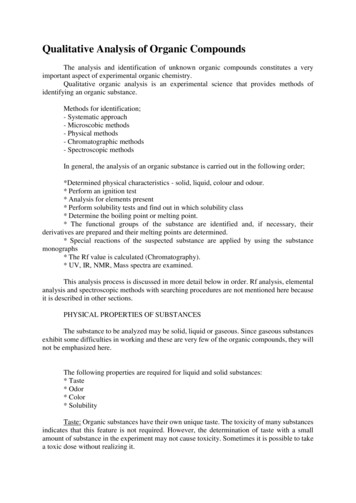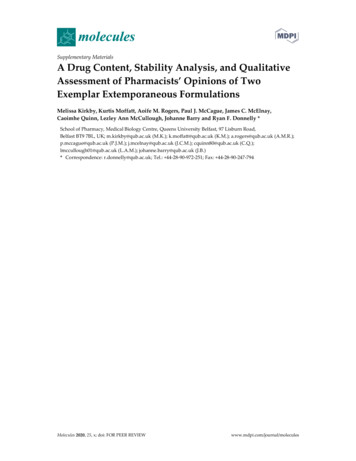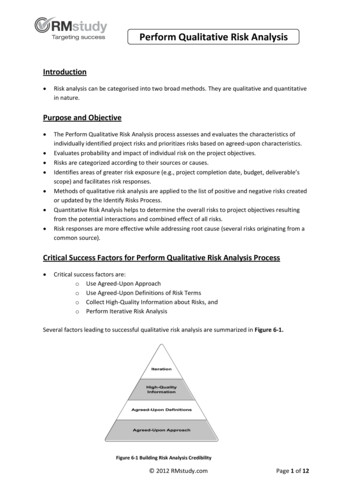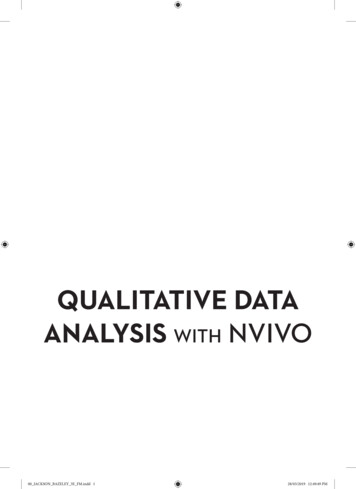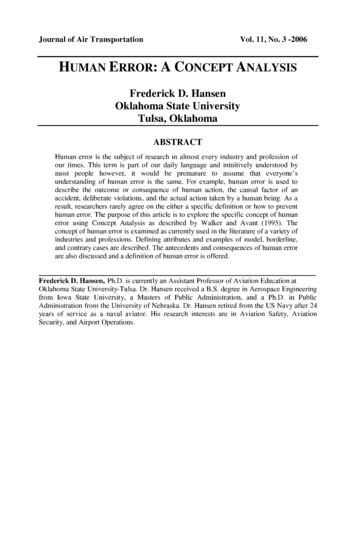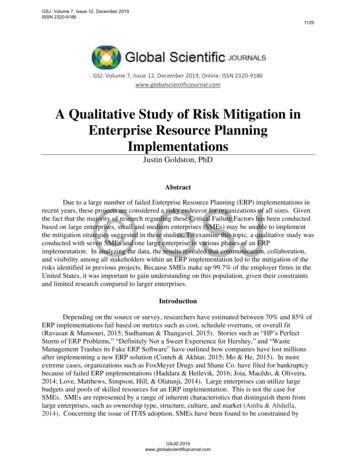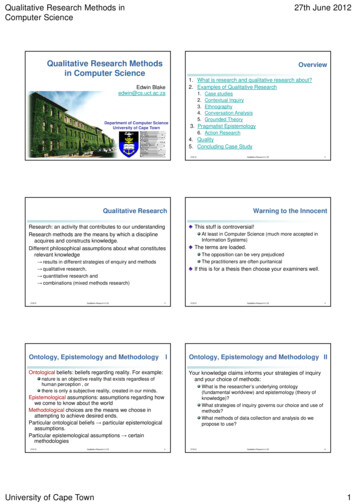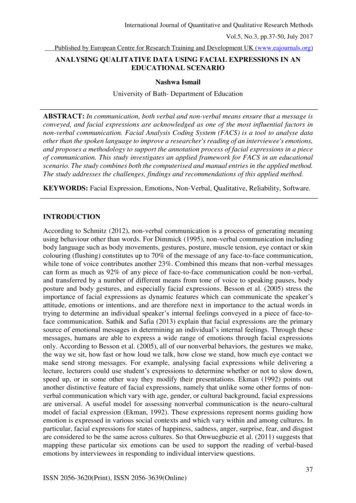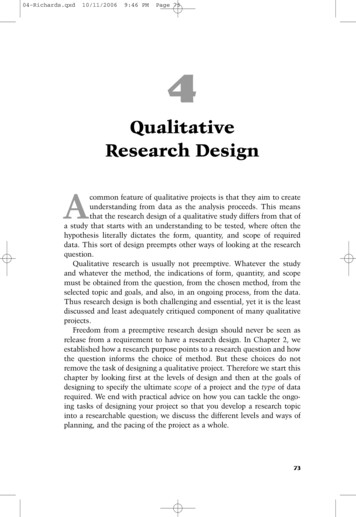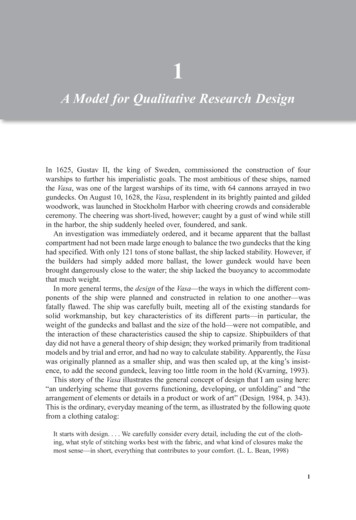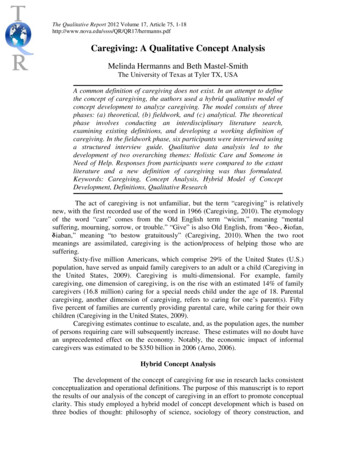
Transcription
The Qualitative Report 2012 Volume 17, Article 75, aregiving: A Qualitative Concept AnalysisMelinda Hermanns and Beth Mastel-SmithThe University of Texas at Tyler TX, USAA common definition of caregiving does not exist. In an attempt to definethe concept of caregiving, the authors used a hybrid qualitative model ofconcept development to analyze caregiving. The model consists of threephases: (a) theoretical, (b) fieldwork, and (c) analytical. The theoreticalphase involves conducting an interdisciplinary literature search,examining existing definitions, and developing a working definition ofcaregiving. In the fieldwork phase, six participants were interviewed usinga structured interview guide. Qualitative data analysis led to thedevelopment of two overarching themes: Holistic Care and Someone inNeed of Help. Responses from participants were compared to the extantliterature and a new definition of caregiving was thus formulated.Keywords: Caregiving, Concept Analysis, Hybrid Model of ConceptDevelopment, Definitions, Qualitative ResearchThe act of caregiving is not unfamiliar, but the term “caregiving” is relativelynew, with the first recorded use of the word in 1966 (Caregiving, 2010). The etymologyof the word “care” comes from the Old English term “wicim,” meaning “mentalsuffering, mourning, sorrow, or trouble.” “Give” is also Old English, from “ eo-, iofan,iaban,” meaning “to bestow gratuitously” (Caregiving, 2010). When the two rootmeanings are assimilated, caregiving is the action/process of helping those who aresuffering.Sixty-five million Americans, which comprise 29% of the United States (U.S.)population, have served as unpaid family caregivers to an adult or a child (Caregiving inthe United States, 2009). Caregiving is multi-dimensional. For example, familycaregiving, one dimension of caregiving, is on the rise with an estimated 14% of familycaregivers (16.8 million) caring for a special needs child under the age of 18. Parentalcaregiving, another dimension of caregiving, refers to caring for one’s parent(s). Fiftyfive percent of families are currently providing parental care, while caring for their ownchildren (Caregiving in the United States, 2009).Caregiving estimates continue to escalate, and, as the population ages, the numberof persons requiring care will subsequently increase. These estimates will no doubt havean unprecedented effect on the economy. Notably, the economic impact of informalcaregivers was estimated to be 350 billion in 2006 (Arno, 2006).Hybrid Concept AnalysisThe development of the concept of caregiving for use in research lacks consistentconceptualization and operational definitions. The purpose of this manuscript is to reportthe results of our analysis of the concept of caregiving in an effort to promote conceptualclarity. This study employed a hybrid model of concept development which is based onthree bodies of thought: philosophy of science, sociology of theory construction, and
2The Qualitative Report 2012participant observation (Schwartz-Barcott & Kim, 1993). Both authors have extensivenursing experience as practicing RNs and current nurse educators as well as researchersstudying chronic illness to advance the nursing profession. Additionally, the authors arecaregivers and have a passion for further exploration of the concept of caregiving, hencethe impetus for this concept analysis. From our experience, we have noted differences inhow both caregivers and care recipients perceive caregiving. Beth stated, “This played arole for me in the inspiration to conduct this study. I remember a care recipientparticipant in a previous study who eloquently described different providers, those thatengaged with him as an individual and those that sat in the corner reading a magazine,doing paperwork or talking on the phone.” Melinda also shared a similar experience witha care recipient, stating that the caregiver who talked to her and saw her as a “person” andnot a just “diagnosis” provided the best care. This led us to wonder: “What iscaregiving?” Also, are there other concepts that more accurately represent a situationwhereby one person is assisting another?We selected a qualitative inquiry using a hybrid model as the most appropriatelevel of inquiry in the exploration of caregiving because this process combines theoreticalanalysis with empirical observation which is helpful since few empirical definitions havebeen written about caregiving. This allows for “a focus on the essential aspects ofdefinition and measurement, . . . is applicable to applied sciences . . .and is especiallyuseful in studying significant and central phenomena in nursing” (Schwartz-Barcott &Kim, 1993, p. 108).This model consists of three phases: (a) theoretical, (b) fieldwork, and (c)analytical. In the initial theoretical phase, a concept is identified and the literature isreviewed for definitions, essential elements of the concept, as well as measurementsrelated to the concept. A working definition is developed (Schwartz-Barcott & Kim,1993). In the second phase, empirical observations and continual review of the literatureare conducted (Schwartz-Barcott & Kim, 1993). The final analysis involves combiningdefinitions derived from the first two phases and may result in possible changes to thedefinition and refinement of the concept (Schwartz-Barcott & Kim, 1993). As a result,several potential outcomes may occur: A new concept may emerge, or, the findings maynot support the concept as it was initially conceived. As a result, the concept may becomemore clearly defined, refined through the process, or a new way to measure the conceptmay emerge.Theoretical Phase (Defining Caregiving)The term “caregiving” is widely used and has been studied from a variety ofscientific perspectives, including nursing, sociology, and psychology (Connell, 2003;Mendez-Luck, Kennedy, & Wallace, 2009). As discussed and illustrated in the literaturereview below, definitions of caregiving typically contained elements related to the act ofcaregiving or tasks performed of caregiving, making the concept difficult to identify(Swanson, Jensen, Specht, Johnson, Maas, & Saylor, 1997). “Caregiving” appears tofollow the logic of monens ponens as illustrated by the following series of statementsshowing circular logic:If my caregiver gives care, then my caregiver is caregiving.
Melinda Hermanns and Beth Mastel-Smith3My caregiver gives care.Therefore, my caregiver is caregiving.The act of the caregiver (precedent) is described by caregiving (antecedent).Subscribing to this logic, caregiver and caregiving equate to the same, when in essence,the terms may represent two entirely different concepts. Therefore, a distinction betweenthe use of the terms, caregiving and caregiver, in the extant literature is warranted. Thisconcept analysis paper will focus solely on the term caregiving for the purpose ofanalyzing the concept of caregiving, using a hybrid concept analysis approach, topromote conceptual clarity.Literature ReviewWe initially chose to search the academic literature published between 20052010; however, we found few definitions and thus expanded our search to become moredate inclusive (1990-2010) using the following databases: Information SystemsIntegration (ISI) Web of Knowledge, Science Direct, Psychology and Social Sciences,Business, Management and Accounting, PubMed, and The National Agricultural Libraryof Agriculture and Allied Disciplines. The authors identified the search terms“caregiving,” “concept analysis,” and “definition” which yielded four results. We thenlimited the search terms to “caregiving” and “definition” and the results elicited 90articles. Ninety-four articles were reviewed and 23 were included in this concept analysis.The inclusion criteria identified by the authors was if a definition of “caregiving”appeared. Articles that did not define “caregiving” and, articles that defined “caregiver”were excluded from this review.The following questions guided the literature search: (a) What is caregiving and(b) Is there a universal definition of caregiving? To differentiate from the individual, thatis, the caregiver, and for a more focused definition of, the search term “caregiving” wasused.Definitions of CaregivingThe etymology of caregiving defined by the Oxford English Dictionary (2010) isas follows:caregiving adj. and n. (a) adj. characterized by attention to the needs ofothers, esp. those unable to look after themselves adequately;professionally involved in the provision of health or socialcare; (b) n. attention to the needs of a child, elderly person, invalid, etc.The Merriam Webster dictionary (2010) defines caregiving as “a person who providesdirect care, as for children, elderly people, or the chronically ill” (¶2). Drentea (2007)refers to caregiving as “the act of providing unpaid assistance and support to familymembers or acquaintances who have physical, psychological or developmental needs”(¶1). Furthermore, Drentea (2007) differentiates caregiving from caring for children,which is parenting; however, if activities performed on behalf of another person are
4The Qualitative Report 2012outside of normal expectations, such as caring for an adult child with cancer, then it isconsidered caregiving. Conversely, Pearlin, Mullan, Semple, and Skaff (1990) definedcaregiving as the “behavioral expression of (one’s) commitment to the well-being orprotection of another person” (p. 583). Caregiving is, in and of itself not a role, rather itentails identified actions within the context of a relationship (Pearlin, Lieberman,Menaghan, & Mullan, 1981). The definitions presented speak to the activities involved inaiding another individual who is dependent in some way. Pearlin et al.’s definition(1990), on the other hand, underscores a specific intent behind the activities, that is, anemotional component and commitment to the relationship as the basis for actions. Thisintent is supported by some caregivers. Specifically, African Americans identified love oraffection as reasons for fulfilling caregiver responsibilities (Nkongho & Archbold, 1995),while other groups did not report similar reasons for providing care (Chao & Roth, 2000;Wallhagen & Yamamoto-Mitani, 2006).The process of caregiving was originally proposed by Bowers (1987) and includesfive categories of roles that provide meaning or purpose for the caregiver: anticipatory,preventive, supervisory, instrumental and protective. Swanson et al. (1997) ultimatelydefines family caregiving as: “Provision by a family care provider of appropriate personaland health care for a family member or significant other” (p. 68), a definition consistentwith those presented above.Caregiving among the DisciplinesSpecific aspects of the concept of caregiving related to several disciplines are addressedbelow, based upon the findings of our literature search.NursingSwanson, et al. (1997), researchers in the College of Nursing, conducted aconcept analysis on family caregiving. This concept analysis focused on the role of thecaregiver. Caregiving was conceptualized as having four characteristics: tasks, transition,roles, and process. Tasks identified include activities of daily living, instrumentalactivities of daily living, the amount of care provided, and direct and indirect care.Transitions focused on care management, delegation, and transfer from family toinstitutional care. Caregiving roles recognized the extension of normal, family care andinvolved “mutual nurturing behaviors” (p. 68). Their ultimate goal was to evaluate theeffectiveness of nursing interventions in family caregiving.SociologySociologists narrowly define caregivers as unpaid workers such as familymembers, friends, and neighbors as well as individuals affiliated with religiousinstitutions (Drentea, 2007). Whereas early caregiving (Luecken & Lemery, 2004) refersto “immediate family environment and is broadly defined to include disruptions inparenting (e.g., as may occur with high family conflict or with parental death or divorce),along with characteristics related to the quality of parenting received by the child, e.g.,caring, abusive” (p. 172), the focus of sociologists has been on examining the global
Melinda Hermanns and Beth Mastel-Smith5perspective of a caregiver in various countries: identifying the caregiver and recipientcharacteristics, such as the most common gender of the caregiver, as well as the caregiverrole, including time spent caregiving, and caregiver burden (Ferrante, 2008; Drentea,2007).Psychiatry/PsychologyIn the disciplines of psychiatry/psychology, the psychological ramifications of theact of caregiving, i.e., caregiving burden and stress have been studied, but caregiving isnot explicitly defined in this arena. The studies located (Stambor, 2006) focused oncaregiver-related characteristics or the effects of caregiving on the caregiver, such ascaregiving demands (Roepke et al., 2009), caregiver stress or burden (Pioli, 2010),coping strategies, challenges, and the rewards of caregiving (Rapanero, Bartu, & Lee,2008).Conceptualizing CaregivingThere is a pressing need for a conceptual framework of caregiving that may helpto guide research and clinical practice. The literature review highlights the lack of auniversal definition for this concept. This lack of a generally accepted definition ofcaregiving makes it difficult to assess the concept of caregiving as well as compare theresults of caregiving research. Disease-specific requirements (i.e., treatment),developmental issues (i.e., illness cognition), and contextual factors (i.e., formal versusinformal care, home versus hospital setting) also complicate the establishment of an allencompassing definition.The lack of a generally accepted definition of caregiving also makes attempts tooperationalize and measure the concept difficult. While a number of instruments relatedto the concept of caregiving are available (see Table 1; 44 tools listed), these tools do notmeasure caregiving itself. Rather they attempt to measure the effects of caregiving, i.e.,management of caregiving tasks: burden, demands, impact, and distress.After reviewing the literature and following the process outlined in the theoreticalphase of this hybrid concept analysis, the authors developed the following workingdefinition: Caregiving is made up of actions one does on behalf of another individual whois unable to do those actions for himself or herself. This definition formed the basis forthe fieldwork we conducted as the second stage of the qualitative concept analysis.Table 1. Caregiving Instruments Caregiving Competence Scale (Pearlin, L. I., Mullan, J. T., Semple, S. J., & Skaff, M. M., 1990).Appraisal of Caregiving Scale (Kinsella, G., Cooper, B., Picton, C., & Murtagh, D., 1998).Caregiving Burden Scale (Schumacher, K. L., Stewart, B. J., Archbold, P. G., Caparro, M., Mutale, F., & Agrawal, S.,2008).Caregiver Demands Scale (Siefert, M. L., Williams, A., Dowd, M. F., Chappel-Aiken, L., & McCorkle, R., 2008).Cargiver Mastery Scale (Sherwood, P. R., Given, B. A., Given, C. W., Schiffman, R. F., Murman, D. L., von Eye, A.,Lovely, M., Rogers, L. R., & Remer, S., 2007).Caregiving Role Demands Scale (Mui, A. C., 1992).Beliefs About Caregiving Scale (Hepburn, K. W., Lewis, M., Narayan, S., Center, B., Tornatore, J., Bremer, K. L., &Kirk, L. N., 2005).Caregiving Activities Scale (Hancock, K., Chang, E., Chenoweth, L., Clarke, M., Carroll, A., & Jeon, Y-H., 2003).
6The Qualitative Report 2012 Caregiving Role—Preplacement (Gaugler, J. E., Zarit, S. H., & Pearlin, L. I., 2003).Caregiving Learning Goal Achievement and Satisfaction Measure (Rosswurm, M., Larrabee, J. H., & Zhang, J., 2002).Caregiver Competence Measure ( Rosswurm, M., Larrabee, J. H., & Zhang, J., 2002).Caregiving Consequences Inventory (Sanjo, M., Morita, T., Miyashita, M., Shiozaki, M.,; Sato, K.,; Hirai, K., Shima, Y.,& Uchitomi, Y., 2009).Impact of Caregiving Scale (Cousins, R., Davis, A. D. M., Turnbull, C. J., & Playfer, J. R., 2002).Caregiving Distress Scale (Cousins, R., Davis, A. D. M., Turnbull, C. J., & Playfer, J. R., 2002).Ways of Coping Scale (Billings, D. W., Folkman, S., Acree, M., & Moskowitz, J. T., 2000).Burden Scale (Ruiz, J. M., Matthews, K. A., Scheier, M. F., & Schulz, R., 2006).Caregiving Stress Measure (Martire, L. M., Keefe, F. J., Schulz, R., Ready, R., Beach, S. R., Rudy, T. E., & Starz, T. W.,2006).Caregiver Stress Scale (Worcester, M. I., & Quayhagen, M. P., 1983).Caregiving Management Scale (Phillips, L. R., Rempusheski, V. F., & Morrison, E., 1989).Zarit Burden Scale (Gaugler, J. E., Kane, R. L., Kane, R. A., & Newcomer, R., 2005).AIDS Caregiver Stress Interview (Wight, R. G., Aneshensel, C. S., & LeBlanc, A. J., 2003).Role Submersion Scale (Chang, B. H., Noonan, A. E., & Tennstedt, S. L., 1998).Respondent's Decision Strategies Scale (Pratt, C. C., Jones-Aust, L., & Pennington, D., 1993).Relatives Stress Scale (Wood, J. B., & Parham, I. A., 1990).Caregiver Competence Scale (Narayan, S., Lewis, M., Tornatore, J., Hepburn, K., & Corcoran-Perry, S., 2001).Caregiving Perceived Control Measure (Sistler, A. B., & Blanchard-Fields, F., 1993). Finding Meaning ThroughCaregiving Scale (Hunt, C. K., 2003).Enmeshment in Caregiving Measure (Braithwaite, V., 1996).Caregiving Hassles Scale (Stephens, M. A. P., Ogrocki, P. K., & Kinney, J. M., 1991).Caregiving Hassles and Uplifts Scale (Kinney, J. M., Stephens, M. A. P., Franks, M. M., & Norris, V. K., 1995).Caregiver Questionnaire (Krach, P., & Brooks, J. A., 1995).Caregiving Satisfaction Scale (Kramer, B. J., 1993).Picot Caregiver Rewards Scale (Picot, S. J. F., Youngblut, J., & Zeller, R., 1997).Caregiving Involvement Scale (Chou, K. R., LaMontagne, L. L., & Hepworth, J. T., 1999).Preparedness for Caregiving Scale (Cummings, S. M., Long, J. K., Peterson-Hazan, S., & Harrison, J., 1998).Caregiver Burden Measure (Dew, M. A., Goycoolea, J. M., Stukas, A. A., Switzer, G. E., Simmons, R. G., Roth, L. H.,& DiMartini, A., 1998).Preparedness for Family Caregiving Measure (Bull, M. J., Hansen, H. E., & Gross, C. R., 2000).Family Caregiving Responsibilities Questionnaire (Fredriksen, K. I., 1999).Willingness to Caregive Scale (Jewell, T. C., & Stein, C. H., 2002).Positive Aspects of Caregiving Scale (Narayan, S., Lewis, M., Tornatore, J., Hepburn, K., & Corcoran-Perry, S., 2001).Role Strain Scale (Tirrito, T., & Nathanson, I., 1994).Caregiving Assistance Scale (Manne, S. L., Lesanics, D., Meyers, P., Wollner, N., Steinherz, P., & Redd, W., 1995).Intention to Caregive Scale (Jewell, T. C., & Stein, C. H., 2002).Beliefs About Parental Caregiving Scale (Jewell, T. C., & Stein, C. H., 2002).Caregiving Strategies Scale (Phillips, L. R., Brewer, B. B., & de Ardon, E. T., 2001).Caregiver Appraisal Measure (Matthews, J. T., Dunbar-Jacob, J., Sereika, S., Schulz, R., & McDowell, B. J., 2004). The Field Work PhaseSchwartz-Barcott and Kim (1993) consider fieldwork an essential element inconcept development. In a hybrid concept development, qualitative data gained byparticipant observation and in-depth interviews are used to develop insight into the natureof the concept. In this study, the fieldwork phase was conducted in both East and SouthEast Texas. Individuals caregiving for a variety of care recipients were recruited (seeTable 2) by the researchers. (Ethics approval was obtained from the university andnongovernmental organizations that agreed to permit us to recruit participants prior toconducting the study.) Purposive sampling was used to recruit potential participants forthe interviews who met the inclusion criteria of English speaking adults 21( years old)who are current or previous caregivers. Purposive sampling is a common approach inqualitative studies. This type of sampling permits the selection of participants whosequalities or experiences permit an understanding of the phenomena in question (Polit &Tatano Beck, 2003).
Melinda Hermanns and Beth Mastel-Smith7Table 2. Demographics of Participants (n casianWhom they Provide Care/# ofYearsCaring for Aunt with anemia,diabetes, arthritis, andosteoporosis/2 yearsCaring for wife withParkinson’s disease/21 yearsCaring for mother withdiabetes, heart disease,pacemaker, and arthritis/10yearsCaring for disabled son withTrisomy 5/7 yearsAnimal caregiver31Female/Asian (Chinese)Registered NurseGiven that the research question in a qualitative concept analysis is focused onone concept determined before data gathering commences, a large number of participantsis not necessary (Schwartz-Barcott & Kim, 1993). Six self-identified caregiversparticipated in semi-structured interviews which lasted on average 45 minutes (see Table2). Participants were asked about their caregiving experiences, what caregiving means tothem, and reasons for caregiving. The interview schedule is presented in Table 3. Theparticipants were ethnically diverse (Caucasian, Asian, and Latino) and both genderswere represented. The participant caregivers included individuals who were eithercurrently caring for or previously caring for a variety of care recipients including spouse,parent, a child with disabilities, and animals.Table 3. Interview Schedule for Caregiving Concept AnalysisFor whom do you provide care?What is your relationship to him /her?Tell me how it is you became a caregiver.What types of things do you do for the person him/her?Describe a typical day.How has caregiving impacted your life?Give me an example of a time when you felt you were caregiving.Give me an example of a time when you were doing something for and you felt you were NOTcaregiving.What are the cultural values or beliefs associated with your background that impact the caregivingprocess?According to your cultural values or beliefs, who should provide caregiving for an older person?What does caregiving mean to you?Some caregivers have told us they have family members that do not participate in caregiving activities fortheir loved one. If this describes your experience, how do you think you are different from them?If you could draw a picture of you doing caregiving, what would it look like? OR If could author a book,what would be the title of your book? OR Can you think of a metaphor or something that describes yourcare giving relationship or the caregiving process?
8The Qualitative Report 2012In this concept analysis, all interviews were tape-recorded and transcribedverbatim by the researchers. After transcription, both researchers reviewed the transcriptsand compared them with the audio recordings to ensure accuracy. The process of codinginvolves segmenting the data into units and rearranging that data into categories whichfacilitate insight and comparison (Miles & Huberman, 1994). Codes serve as organizingdevices that allow rapid retrieval and clustering of all the segments related to a particularquestion, concept, or theme (Miles & Huberman, 1994). The researchers identifiedrelationships, patterns, themes, and categories related to the phenomena of studydeveloped theme-based tables. An iterative process continued throughout the entireanalysis process to ensure that data were authentically represented.ResultsThe research question that guided the analysis was, “What is caregiving?”Analysis of the data led to two overarching themes: Holistic Care and Someone in Needof Help and the identification of two categories: (a) Actions Performed On Behalf ofAnother and (b) Essential Elements. The sub-categories are: Requisite CaregivingCharacter Traits,Requisite CaregivingEmotions,Requisite CaregivingKnowledge/Skills, Temporal Aspects, and Emotional Connection emerged (see Figure 1).Figure 1: Schematic Presentation of FindingsTheme 1: Holistic CareThe participant caregivers talked about caring for their care recipient’s physical,mental, and spiritual needs. The actions performed and the care delivered was identifiedas holistic. A female caregiver who currently cares for her disabled son stated that shewitnessed nurses doing “scheduled maintenance, not holistic care.” She wholeheartedlybelieved caregiving was delivering holistic care, “the holistic care of the person, not justseeing to their medical needs, not just seeing their physical needs, but to their mentalneeds, their spiritual needs, you know to make them a whole person.” Anotherparticipant enthusiastically shared that caregiving is “the strong desire to make thingsbetter . . . to give a voice . . .” While another participant did not explicitly use the term
Melinda Hermanns and Beth Mastel-Smith9“holistic,” he talked about the importance of attending to his wife’s physical, emotional,and spiritual well-being. He passionately defined caregiving as:It’s care to keep the patient functional and keep their spirit up so that theycan function as good as they can under the circumstance. It’s soimportant to keep them physically and mentally as high as you can Wedon’t really know how tough it is because we’re not locked in a body thatdoesn’t perform, you know. And so we, I guess, we’re just happy that weare able to help the people, you know, the patient.A participant who is a registered nurse (RN) also talked about delivering holistic care,attending to the physical (reducing pain, giving medications), but also addressing theemotional issues and being understanding by making sure that all needs are met. Shefurther described the importance of holistic care in her delivery of nursing care.Caregiving I think the caregiving includes a lot of layers, a lot of levels.Most basically, you have to make sure that everything is okay with thepatient physically, make sure they don’t develop any infection after thesurgery, make sure they understand the importance of meds, make suretheir pain level is under control and they’re taking like their bloodpressure, blood sugar is, you know, within acceptable level. And also, thisis the physical part and also the emotional parts. When they feel anxious,nervous, if it’s possible spend more time with them.Additionally, the RN reinforced the holistic component of caregiving as the“physical caregiving, emotional caregiving, there’s family caregiving that has elements ofeducation in that you need to keep them informed of everything that’s going on and knowwhat’s going to happen.” When participants were asked to identify a time when they feltthat they were not caregiving, the RN shared a situation where a colleague was notdelivering holistic care. A nurse was fired because she was supposed to straight catheterher patient every four hours. While the nurse charted that she performed the straightcatheter procedure, she in fact, had not. The nurse participant stated,I think she didn’t have the patient interests and feelings in her mind. Evenwhen you’re not a professional nurse, you should know that those kind offeelings, like distended bladder or pain is not something that somebodyshould bear for 12 hours. You need to have those, you know, the patientinterest in your mind. Not just a passive care giver, you only wait whenthey call you.Theme 2: Someone in Need of CareAll of the caregivers were providing care for someone in need of care. The carerecipients had a variety of diagnoses or multiple illnesses from a birth defect to surgery.Many of the participants talked about how their care recipient needed care. Oneparticipant passionately illustrated the theme, “Someone in Need of Care,” through her
10The Qualitative Report 2012statement, “An illness, a surgery, a point that they come to where they can’t do certainthings themselves.” While the majority of the caregivers did not have any healthcareexperience, they were committed to learning how to perform the duties needed to providecare for their care recipients. Additionally, all of the participants were committed todelivering the best possible care to their care recipients. All of the participants in thisstudy, with the exception of the nurse, fell into the caregiver role by default (as themother or spouse), or life circumstances of the caregiver and other family members.Regardless of how they evolved in the caregiver role, all participants were willing tolearn, and subsequently learned specific actions/duties necessary to better care for theindividual needs of their care recipients. The specific actions will be discussed in thefollowing paragraph.Category 1: Actions Performed On Behalf of AnotherThe dictionary definition of caregiving--actions that one person does on behalf ofanother--guided the interview question, “What kind of things do you do for your carerecipient?” All of the caregivers assumed the role of an advocate; advocating for the bestpossible care for their care recipient. Many shared stories/examples of when theyassumed the role of an advocate for their care recipients. Participants also openlydiscussed the actions they routinely performed. Tasks varied according to the carerecipient’s individual needs and diagnosis, ranging from activities of daily living, such asbathing, toileting, and feeding, to instrumental activities of daily living, i.e., medicationadministration, accompanying to doctor visits, ambulation and routine household chores(Table 4). A participant in her fifties caring for her aunt stated, “I was fixing all herevening meals I drive her everyplace.” The male participant stated, “Before the deepbrain stimulation, I had to help her with everything. Now, I help her dress, help her to thebathroom.” The actions that the RN participant routinely performed were as follows:taking vital signs, assessing intake and output, completing physician’s orders, educatingpatients and family as well as ensuring patient safety. The tasks performed by thecaregiver of a pet were involvement in end-of-life care and ensuring a safe environment.All of the participants talked about providi
entails identified actions within the context of a relationship (Pearlin, Lieberman, Menaghan, & Mullan, 1981). The definitions presented speak to the activities involved in aiding another individual
